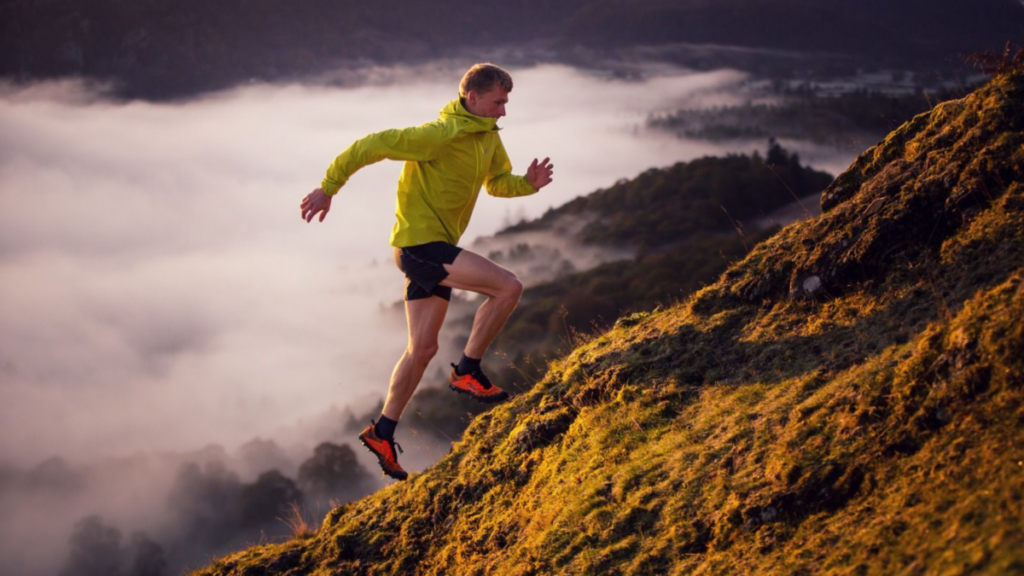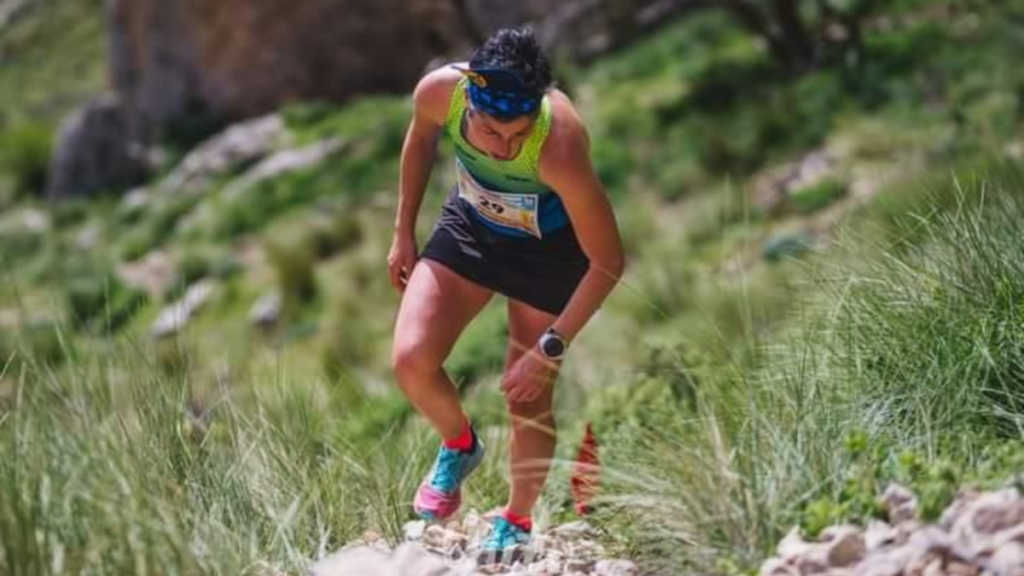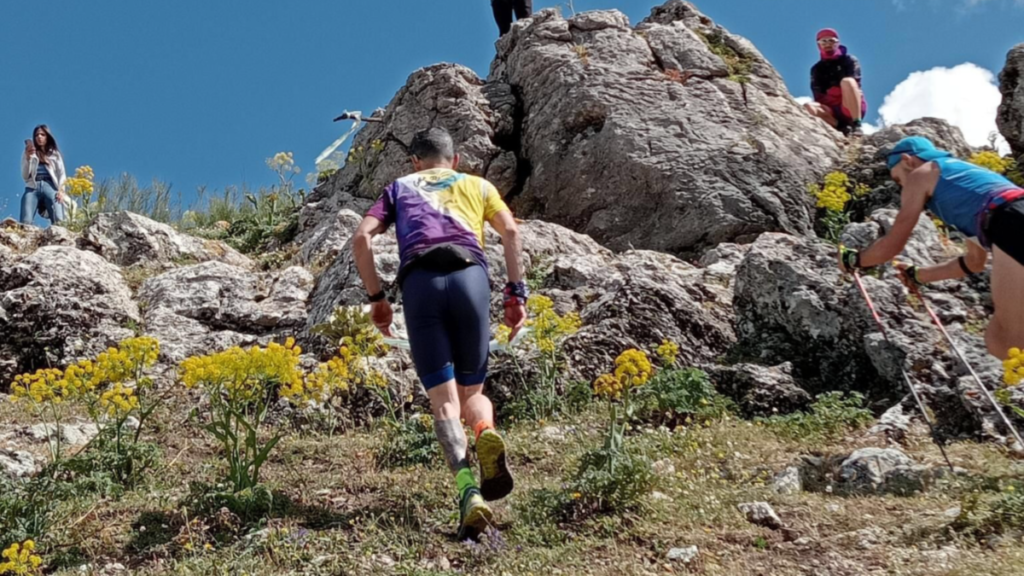
I can still remember the autumn afternoon when my friend David suggested the idea of doing a vertical kilometre race. We were relaxing at a café stop 12 miles into our trail run linking mountain villages in the south of Spain.
“I will be fun,” he said. “Our endurance is easily enough to cope with something that will be finished quickly.”
If only I’d known then what I know now.
Vertical kilometer races are short but extremely taxing mountain events where runners ascend 1000m (3300ft) vertically, usually over a distance of about 1km horizontally. This makes the average gradient 45 degrees, but many sections are much steeper than that.
Let’s study the world of vertical kilometre in greater detail so that you can prepare for, and cope with these unique events.
What are Vertical Kilometer Races
Vertical Kilometer Races, also known as VK races, are extreme mountain running events that challenge participants to ascend 1,000 meters in vertical elevation over a course typically spanning just one kilometer horizontally. These races originated in Europe and have gained popularity worldwide due to their unique blend of endurance, strength, and mental fortitude required to conquer steep inclines and rugged terrain.
Participants in VK races face a myriad of challenges, including the relentless uphill climb, varying weather conditions, and the need for specialized gear and training. The intensity of these races demands a high level of physical fitness and mental resilience, making them a true test of an athlete’s capabilities.
VK races attract a diverse range of participants, from seasoned mountain runners seeking a new challenge to adventurous individuals looking to push their limits in a breathtaking natural setting. The allure of conquering towering peaks and experiencing the thrill of vertical ascents appeals to those who crave adrenaline-fueled adventures and seek to connect with nature in a unique and exhilarating way.
Notable Vertical Kilometer Race Locations Around the Globe
Vertical kilometer races take participants to some of the most breathtaking and challenging locations worldwide. One iconic race location is the “Monte Rosa Massif” in the Italian Alps, where runners ascend steep slopes surrounded by stunning glaciers and rocky peaks. The rugged terrain and high altitude of this race present a true test of endurance and skill.
Another renowned race destination is the “Tianmen Mountain” in China, known for its vertigo-inducing cliffside paths and stunning natural beauty. Participants navigate narrow trails and steep staircases, offering a unique blend of physical challenge and awe-inspiring views.
Moving to the Americas, the “Pikes Peak” in Colorado, USA, stands out as a classic vertical kilometer race location. Runners tackle the steep incline of this iconic mountain, testing their strength and determination against the backdrop of the Rocky Mountains.

These locations not only provide a challenging race experience but also offer participants the opportunity to immerse themselves in diverse landscapes and cultures, making vertical kilometer races a truly global adventure.
Training Tips for Vertical Kilometer Races
For aspiring vertical kilometer race participants, preparation is key to success. Incorporating interval training into your regimen can help build endurance, power, and speed, essential for conquering steep ascents. Focus on uphill running to simulate race conditions and strengthen the muscles used during climbs. Additionally, strength training targeting the legs, core, and upper body is crucial for maintaining form and power throughout the race.
It’s also vital to practice hill repeats to improve your ability to tackle inclines efficiently. These repetitions will not only enhance your physical conditioning but also boost your mental resilience when faced with challenging terrains. Remember to hydrate adequately during training sessions to simulate race-day conditions and optimize performance.
Lastly, consider seeking guidance from experienced coaches or joining a running group to gain valuable insights and support. By following these training tips and staying dedicated to your goals, you’ll be well-prepared to take on the vertical kilometer race challenge with confidence and determination.
Gear Essentials: What You’ll Need for Vertical Kilometer Races
When gearing up for a vertical kilometer race, having the right equipment is crucial for your performance, safety, and overall comfort during the challenging ascent. One essential piece of gear is a pair of trail running shoes with excellent grip and support to navigate steep and rugged terrain effectively. These shoes provide stability and traction, reducing the risk of slips and falls on rocky surfaces. Take into account the kind of surface you will be running on. Sand, dirt, rocks, and snow each require different types of shoe soles to get maximum traction.
Another key item to consider is a hydration pack or lightweight water bottle to stay hydrated throughout the race. Proper hydration is vital for maintaining energy levels and preventing fatigue during the intense uphill climb. When choosing your hydration system for a race, take into account your estimated time to complete the route and pack enough water for that amount of time. Carrying additional water for a VK race means extra weight, which will slow you down. It is a fine balance to carry just the right amount of water.
Additionally, wearing moisture-wicking compression clothing can help regulate body temperature and reduce chafing, enhancing your comfort and performance. Again here, weight is important. Many of the VK races that I’ve done allow athletes to have a gear bag transported to the finish. My gear bag will usually include dry t-shirt and socks. I’ll also pack a sweater and/or a lightweight jacket as well as a cap/beanie depending on the weather conditions. My gear bag will always have some electrolyte drink and a recovery drink so that I can replace glycogen as soon as possible after finishing.
To ensure your safety, don’t forget to pack a headlamp or flashlight if the race takes place in low-light conditions or early morning hours. However, most VK races take place during optimal conditions making a headlamp or torch unnecessary. That being said, I always keep a headlamp in my training pack. This will help you navigate the trail with ease and avoid obstacles along the way.
By investing in quality gear that prioritizes performance, safety, and comfort, you’ll be well-equipped to tackle the vertical kilometer race with confidence and efficiency.
Nutrition and Hydration Strategies for Vertical Kilometer Races
Proper nutrition and hydration are paramount for success in vertical kilometer races, ensuring optimal performance and endurance throughout the challenging ascent. Hydration plays a crucial role in maintaining energy levels and preventing dehydration, especially in high-altitude environments where fluid loss is accelerated. It’s essential to carry a lightweight hydration pack or water bottle to replenish fluids regularly during the race.

I have never eaten anything during a VK race. The extreme effort of sprinting up a hill for a relatively short period of time makes it impossible for me to eat anything while trying to suck in as much air as I can. Even if I could swallow anything, I doubt that I would be able to keep it down. So, when it comes to the nutrition that I refer to below, I’m talking about pre-race nutrition, post-race recovery as well as training.
When it comes to nutrition, focus on easily digestible carbohydrates to fuel your muscles efficiently. Energy gels, bars, or dried fruits can provide quick energy boosts during the intense uphill climb. Additionally, incorporating electrolyte-rich snacks like nuts or sports drinks can help replenish essential minerals lost through sweat.
Timing is key when it comes to nutrition intake. Consume small, frequent snacks before the race to sustain energy levels without causing digestive discomfort. Experiment with different foods during training to identify what works best for your body and helps you perform at your peak during vertical kilometer races. By prioritizing proper nutrition and hydration strategies, you’ll enhance your performance and endurance in these demanding races.
Common Challenges Faced During Vertical Kilometer Races
Vertical kilometer races present a unique set of challenges that test participants both physically and mentally. One of the most common hurdles athletes face is the steep incline, which places immense strain on leg muscles and cardiovascular endurance. This intense uphill climb demands exceptional lower body strength and cardiovascular fitness to maintain a steady pace and conquer the elevation gain efficiently.
Another significant challenge is the mental aspect of vertical kilometer races. The relentless ascent can be mentally taxing, requiring a strong mindset to push through fatigue, self-doubt, and the urge to slow down or stop. Mental resilience and determination are crucial for overcoming these internal obstacles and staying focused on the ultimate goal of reaching the summit.
Environmental factors also play a role in the challenges faced during vertical kilometer races. Participants must contend with varying weather conditions, altitude effects, and rugged terrain, adding complexity to an already demanding race. Adapting to these environmental challenges requires careful preparation, flexibility, and the ability to adjust race strategies on the fly.
By understanding and preparing for these common challenges, athletes can better equip themselves to tackle the rigors of vertical kilometer races and enhance their overall race experience.
Safety Precautions and Considerations
Before embarking on a vertical kilometer race, it is crucial for participants to prioritize safety to ensure a successful and enjoyable experience. “Proper preparation” is key, starting with a thorough understanding of the race course, terrain, and weather conditions. Familiarize yourself with the route, potential hazards, and emergency exit points to mitigate risks effectively.
“Appropriate gear” is essential for safety during vertical kilometer races. Invest in high-quality trail running shoes with excellent grip for traction on steep slopes. Additionally, wear moisture-wicking clothing to stay dry and comfortable throughout the race. Don’t forget essential safety gear like a hydration pack, emergency whistle, and a fully charged mobile phone for emergencies.
During the race, “hydration and nutrition” are paramount for maintaining energy levels and preventing dehydration. Carry sufficient water and energy snacks to fuel your body during the intense climb. Listen to your body’s signals and take breaks when needed to avoid overexertion and potential injuries.
After the race, prioritize “recovery and rest.” Allow your body time to recuperate from the demanding effort. Stretch, hydrate, and refuel with nutritious foods to support muscle recovery and overall well-being. By following these safety precautions and considerations, participants can enjoy the thrill of vertical kilometer races while prioritizing their well-being.
The Evolution of Vertical Kilometer Races: Trends and Innovations
As vertical kilometer races have gained popularity worldwide, the sport has undergone significant evolution, adapting to meet the demands of both athletes and enthusiasts. One notable trend is the increasing accessibility of these races, with more events being organized in diverse locations to cater to a broader audience. This trend aligns with the growing interest in outdoor activities and adventure sports among individuals of all ages and backgrounds.
Innovations in technology have also played a crucial role in shaping the evolution of vertical kilometer races. Advanced gear and equipment, such as lightweight yet durable trail running shoes and specialized hydration packs, have enhanced the performance and safety of participants. Additionally, the use of GPS tracking devices and online platforms for race registration and tracking has streamlined the organization of events, making them more efficient and engaging for both athletes and spectators.
Overall, the evolution of vertical kilometer races reflects a dynamic and progressive sport that continues to push boundaries and inspire a sense of community among participants. As the sport evolves, it is essential to embrace these trends and innovations while upholding the core values of camaraderie, sportsmanship, and respect for the environment.
Environmental Impact and Conservation Efforts
The growing popularity of vertical kilometer races raises concerns about their environmental impact on natural landscapes and wildlife. As athletes conquer steep terrains and rugged mountains, the delicate ecosystems they traverse may face disturbances. It is crucial to address these impacts through proactive conservation efforts to ensure the long-term sustainability of these races.
Conservation initiatives play a vital role in mitigating the environmental footprint of vertical kilometer races. Strategies such as trail maintenance, reforestation projects, and wildlife protection programs are essential to preserve the biodiversity of race locations. By working closely with environmental organizations and local communities, race organizers can implement sustainable practices that minimize ecological harm and promote responsible outdoor recreation.
Moreover, raising awareness among participants and spectators about the importance of environmental stewardship is key to fostering a culture of conservation within the vertical kilometer racing community. Encouraging practices like Leave No Trace principles, waste reduction, and eco-friendly event management can significantly contribute to minimizing the races’ impact on the environment.
By prioritizing conservation efforts and sustainability practices, vertical kilometer races can continue to thrive while respecting and protecting the natural environments that make these events so unique and exhilarating.
Notable Athletes and Records in Vertical Kilometer Racing
Vertical kilometer racing attracts a diverse array of talented athletes who push the boundaries of human endurance and speed. Among the elite competitors, names like “Kilian Jornet” and “Emelie Forsberg” stand out as trailblazers in the sport, setting records and achieving remarkable feats on some of the world’s most challenging vertical courses. Kilian Jornet, known for his unparalleled speed and mountain prowess, has shattered records on iconic races like the “Vertical Kilometer of Fully” in Switzerland, showcasing his exceptional climbing abilities and mental fortitude.
Emelie Forsberg, a dominant force in women’s vertical kilometer racing, has conquered steep ascents with grace and determination, securing victories in renowned events such as the “Tromsø Skyrace Vertical Kilometer” in Norway. Her achievements not only inspire aspiring athletes but also highlight the growing competitiveness and skill level within the vertical kilometer racing community.
These exceptional athletes serve as role models for aspiring racers, demonstrating the dedication, skill, and resilience required to excel in this demanding sport. Their records and achievements not only showcase the pinnacle of performance in vertical kilometer racing but also contribute to the rich tapestry of stories that define the allure and excitement of this unique racing discipline.
Community and Culture Surrounding Vertical Kilometer Races
The community and culture surrounding vertical kilometer races are integral to the sport’s appeal and growth. Participants and enthusiasts form a tight-knit community bonded by their shared passion for conquering extreme vertical challenges. Locally, these races often bring together individuals from diverse backgrounds, united by a common goal of pushing their physical and mental limits. The camaraderie among racers is palpable, with seasoned athletes offering support and encouragement to newcomers, fostering a welcoming and inclusive environment for all.
Globally, the culture of vertical kilometer races transcends borders, connecting like-minded individuals from different corners of the world. Social media platforms and online forums serve as hubs for sharing experiences, training tips, and race strategies, creating a virtual community that extends beyond race days. This global network allows participants to learn from each other, celebrate achievements, and forge friendships that endure beyond the finish line.
The sense of community and camaraderie in vertical kilometer racing not only enhances the overall race experience but also contributes to the sport’s continued popularity and evolution. As the community grows, so does the collective spirit of resilience, determination, and mutual support that defines the culture of vertical kilometer races.
The Future of Vertical Kilometer Races: Predictions and Exciting Developments
As vertical kilometer races continue to gain popularity worldwide, the future of this extreme sport holds exciting possibilities and challenges. Looking ahead, two key aspects are crucial to consider: technological advancements and sustainability efforts.
In terms of technological advancements, we can anticipate the integration of cutting-edge gear and equipment designed to enhance performance and safety for athletes. Innovations in materials, such as lightweight yet durable fabrics and advanced GPS tracking systems, are likely to revolutionize how races are conducted and experienced. Additionally, the use of virtual reality and augmented reality technologies may offer participants immersive training experiences and virtual race simulations, further blurring the lines between physical and digital realms.
On the other hand, sustainability efforts are poised to play a significant role in shaping the future of vertical kilometer races. With a growing emphasis on environmental conservation and eco-friendly practices, race organizers and participants are expected to prioritize sustainability in event planning and execution. Initiatives like zero-waste events, carbon offset programs, and eco-conscious gear choices are likely to become standard practices, ensuring that the sport remains in harmony with nature and minimizes its ecological footprint.
By embracing technological innovations and sustainable practices, the future of vertical kilometer races is set to be both thrilling and environmentally conscious, catering to a diverse community of athletes and nature enthusiasts alike.
